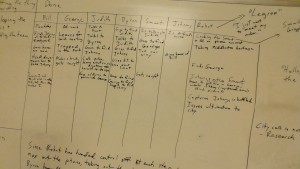For me, the Solemnity of Mary the Mother of God is a wonderful way to start the year 2015, because this is to be the year of writing. Most of my hopes for the coming twelve months seem less matter for resolutions than matter for prayer: health, sanity, equilibrium, organization—that last one in particular just needs a miracle. But this much is resolved for 2015: I will write and write and write.
I will write theological stuff, of course. A particular book has been gestating for too long, and I need to birth the thing before it gets so big it breaks something. I do not have so much a thesis in mind as a vision: lots of dots connect in my mind, and I need to get the whole web down on paper. Have you ever wondered how the doctrine of the Mystical Body of Christ connects to the idea of the Great Books? Have you ever sat up trying to see how the fact of the Trinity relates to the experience of reading Scripture? Well, stay tuned.
But maybe even more that than, I need to write fiction. My colleagues are puzzled by the urge, but I’ll repeat the key word: need.
Something magical happens when you write a story: connections appear that you could never have seen any other way. Are you puzzled by a story in the Bible? Try your hand at writing a novella about it and you’ll see it open before your wondering eyes. Stuck on planning a party? Write a short story about what happened at the party and you’ll suddenly see how to lay everything out. Or at least, that’s what happens for me and for lots of other people.
This is the drive, I suspect, behind the Jewish tradition of Midrash. As long as you sit in front of the text and “respect” it, that is, leave it alone and try to hear its voice without in any way affecting it, the text holds its dearest secrets close. But when you see the text as a bunch of dots on a paper just waiting for you to draw all the lines, suddenly the thing rushes out to embrace you and explain itself to you.
I find that the magic lingers long after I have stopped writing. If I have written fiction recently, everything in life is more creative and energetic. I see more connections everywhere, my theology comes alive, my kids enjoy me more—and heck, sometimes I’m even more organized!
By now, I suppose you are wondering what all this has to do with the Solemnity of Mary of the Mother of God. Well, Mary should be the writer’s patroness: she published just one Word and has been getting continual press ever since. Mary the mother of God, pray for us.


